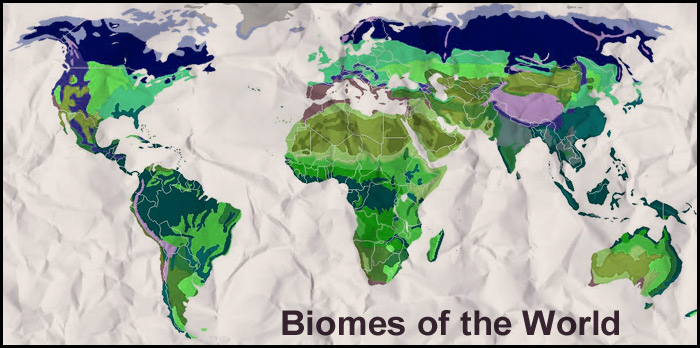Biomes of the World
What is a Biome?
A biome is a large geographical area of distinctive plant and animal groups which are adapted to that particular environment. Most terrestrial biomes are defined by the dominant plant life. The plant life is determined in part by the climate in a region, and climate is controlled by many factors, including latitude and geography.
A Video Introduction to Climates
This short video was made for Pearson‘s middle school curriculum. Overall we made 65 videos for grades 6-8. We’re happy to get the chance to share this one with you here. If you like it, please follow us on YouTube, Instagram, and Twitter and like us on Facebook.
Most textbooks define only terrestrial biomes. Technically this it the most precise definition. But we have included what we call aquatic biomes because many students search for them as biomes. In reality, most aquatic biomes are more correctly called aquatic zones.

To understand a world biome, you need to know:
- What the climate of the region is like
- Where each biome is found on Earth and what its geography is like
- The special adaptations of the vegetation
- The types of animals found in the biome and their physical and behavioral adaptations to their environment
Terrestrial Biomes

Terrestrial biomes are defined by the dominant vegetation. For example, a deciduous forest is made up primarily of non-evergreen trees. A temperate grassland is dominated by grasses. A boreal forest is made up primarily of evergreen trees such as spruce and fir. Read up on each biome to learn more. We’ve created a video for most temperate biomes. (Some of these links direct you to our biome pages at thewildclassroom.com)
- Arctic Tundra
- Alpine Tundra
- Boreal Forests (Taiga)
- Chaparral / Mediterranean climates
- Coniferous Forests
- Desert
- Desert Scrub
- Polar Icecaps
- Temperate Deciduous Forest
- Temperate Grasslands
- Tropical Rainforests
- Tropical Savannas
Aquatic Biomes

Aquatic Biomes, sometimes called “zones,” are often overlooked. Because many of the staff here at Untamed Science are marine biologists, we made sure to not forget them. In fact, we teamed up with Save our Seas to produce a video for every biome. Check them out:
Ocean Aquatic Biomes / Zones
Freshwater Aquatic Biomes / Zones
Check out some of the videos we’ve created on thewildclassroom.com BIOMES OF THE WORLD pages.
Related Topics
What is a Biome?
A biome is a large geographical area of distinctive plant and animal groups which are adapted to that particular environment. Most terrestrial biomes are defined by the dominant plant life. The plant life is determined in part by the climate in a region, and climate is controlled by many factors, including latitude and geography.
A Video Introduction to Climates
This short video was made for Pearson‘s middle school curriculum. Overall we made 65 videos for grades 6-8. We’re happy to get the chance to share this one with you here. If you like it, please follow us on YouTube, Instagram, and Twitter and like us on Facebook.
Most textbooks define only terrestrial biomes. Technically this it the most precise definition. But we have included what we call aquatic biomes because many students search for them as biomes. In reality, most aquatic biomes are more correctly called aquatic zones.

To understand a world biome, you need to know:
- What the climate of the region is like
- Where each biome is found on Earth and what its geography is like
- The special adaptations of the vegetation
- The types of animals found in the biome and their physical and behavioral adaptations to their environment
Terrestrial Biomes

Terrestrial biomes are defined by the dominant vegetation. For example, a deciduous forest is made up primarily of non-evergreen trees. A temperate grassland is dominated by grasses. A boreal forest is made up primarily of evergreen trees such as spruce and fir. Read up on each biome to learn more. We’ve created a video for most temperate biomes. (Some of these links direct you to our biome pages at thewildclassroom.com)
- Arctic Tundra
- Alpine Tundra
- Boreal Forests (Taiga)
- Chaparral / Mediterranean climates
- Coniferous Forests
- Desert
- Desert Scrub
- Polar Icecaps
- Temperate Deciduous Forest
- Temperate Grasslands
- Tropical Rainforests
- Tropical Savannas
Aquatic Biomes

Aquatic Biomes, sometimes called “zones,” are often overlooked. Because many of the staff here at Untamed Science are marine biologists, we made sure to not forget them. In fact, we teamed up with Save our Seas to produce a video for every biome. Check them out:
Ocean Aquatic Biomes / Zones
Freshwater Aquatic Biomes / Zones
Check out some of the videos we’ve created on thewildclassroom.com BIOMES OF THE WORLD pages.
































































































